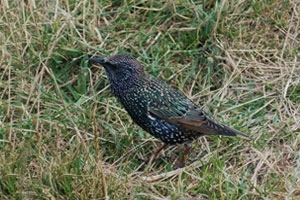Starling (Sturnus vulgaris)
 Starlings are beautiful as well as being remarkable birds. There is a statement that many will disagree with and I know that they are unpopular with stock farmers in many parts of the country, because they not only eat the food given to cattle, but also defecate on it as well. They can also create a major problem if they choose YOUR wood to roost in, as thousands of roosting birds night after night can make a real mess – and they are incredibly difficult to move on!
Starlings are beautiful as well as being remarkable birds. There is a statement that many will disagree with and I know that they are unpopular with stock farmers in many parts of the country, because they not only eat the food given to cattle, but also defecate on it as well. They can also create a major problem if they choose YOUR wood to roost in, as thousands of roosting birds night after night can make a real mess – and they are incredibly difficult to move on!
However, I have always had a soft spot for starlings ever since I helped my school biology teacher in Worcestershire ring a nestling, only to have the ring returned 18 months later from a Russian who had found the bird on the outskirts of Moscow! If you take a close look at a starling in full breeding plumage in the spring, far from being a dull blackish bird, its plumage becomes iridescent with various shades of green and purple and a smattering of flecks and spots. At this breeding time of year the male is most likely to be found singing his medley of whistles, clicks and mutterings as well as mimicking telephone ring calls, car alarms and even other birds singing.
Even though the starling is a common bird in most areas, as a breeding bird its numbers are declining steeply, probably as a result of the “improvement” of many of our grass fields. Starlings like to gather earthworms and leather jackets to feed their young by foraging on short swards with high levels of the target prey, and these are generally found in unimproved grasslands where little or no fertiliser is used.
During the winter months when we still see vast flocks of these birds, it is hard to believe that they are in fact declining. However, many of the starlings we see are continental and not our own “home bred” birds. To see thousands upon thousands of these birds circling around before dropping as one into the roosting site is a superb spectacle. Some of the roosting sites chosen are clever too, with the warm lights on many of our city centre buildings being a cosy way to spend a mid-winter night.
But have you ever wondered how these thousands of birds, swirling and turning as one giant flock, never ever seem to crash into each other? Well, current computer models assume that each bird interacts with all birds within a certain distance. But new observations, however, show that each bird keeps under control a fixed number of neighbours - seven other starlings - irrespective of their distance, which is the secret of how they stick together!
So, don’t be too hard on the starling – they really are amazing creatures!
Peter Thompson
Advisory

Download Peter Thompson's essential 26-page book, featuring beautiful photography and detailed profiles of Britain's wildlife
Download FREE >